What I learned rolling with the Swifties (transit version)
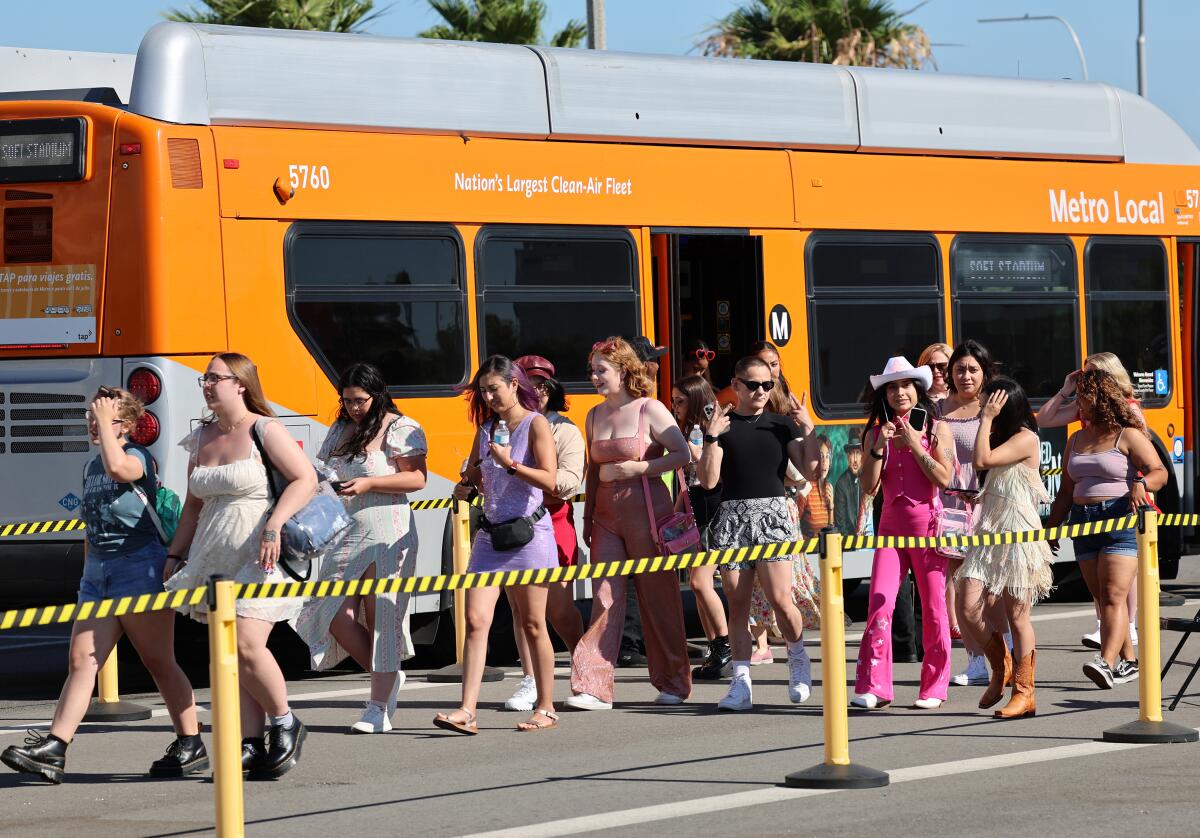
Good morning, and welcome to the Essential California newsletter. It’s Monday, Aug. 7.
If you live in Greater L.A., you probably know that Taylor Swift is in town.
Even if you’re not a fan of her music, her arrival is poised to bring something big to our city — nearly everywhere Swift has taken her tour, cities have seen boosts in public transit ridership and the overall economy.
So far, the Los Angeles County Metropolitan Transportation Authority has prepared for the former with ramped-up service for each day of the tour, which began Thursday. The fourth of the singer-songwriter’s six sold-out Eras tour shows at SoFi Stadium in Inglewood is scheduled for Monday night.
I was curious to see how Swifties would take to regional transit, especially given our car-centric sprawl compared with many other cities, where Swift’s fans have absolutely packed trains and buses.
So on Thursday, I rode with the Swifties to learn more about their passion for the superstar — and why concertgoers are (but mostly are not) choosing transit over driving.
A slow start to Inglewood
Depending on how far you are from Inglewood, making the journey by transit isn’t necessarily easier — though it does give you more time to take in the local scenery.
I began my car-free trip from Pasadena, walked 15 minutes to the nearest A Line station, loaded my Tap card for the night’s trips ($1.75 each way) and waited for the train. That’s when I noticed alerts on the overhead displays: emergency repairs on the A Line meant trains were now running every 20 minutes or more. Terrific.
My trip ultimately required three trains, three transfers and a bus. It also took longer than I’d hoped, thanks to that A Line lag and then a second delay at the Pico Station that left an incoming E Line train idling for almost 10 minutes before it could pull up to the platform.
It was largely devoid of Swifties until I got on the E Line, when I finally encountered a group of women who seemed to be headed to the show.
Bedazzled eye makeup? Check.
Friendship bracelets? Check.
General exuberance? Check.
Friends Zoe Albano-Oritt, Ekaterina Vladimirova, Ana Robinson and Maddie Herbik told me they decided to take transit after Herbik saw and shared an L.A. Metro TikTok video about the Swiftie service. They live in L.A., except for Robinson, who moved to Washington, D.C., but came back for the concert.
I asked: Is there a Taylor Swift song or lyric that describes their transit moment?
“I’m drunk in the back of the car,” Albano-Oritt joked, holding a tall can of Modelo.
The friends don’t take transit often — it was Albano-Oritt’s first time — but they said the experience went smoothly and all the signage was helpful.
“[It’s] very efficient and quick and easy to figure out where you’re going,” Albano-Oritt told me. “I feel like it’s been a lot faster than it would have been if we decided to drive.”
It’s important to disclose here that while I know a thing or two about local transit, I’m far less knowledgeable about the world of Taylor Swift.
As we rode the K Line, the friends were my guides. They showed me their bracelets, each with a word or phrase from a Swift song that held meaning to them. Albano-Oritt and Vladimirova also filled me in on a conspiracy theory among some Swifities — which they ascribe to — that Taylor is secretly queer, based on supposed clues in some of her song lyrics.
“We need to get lives,” Albano-Oritt said. “It’s such a rabbit hole.”
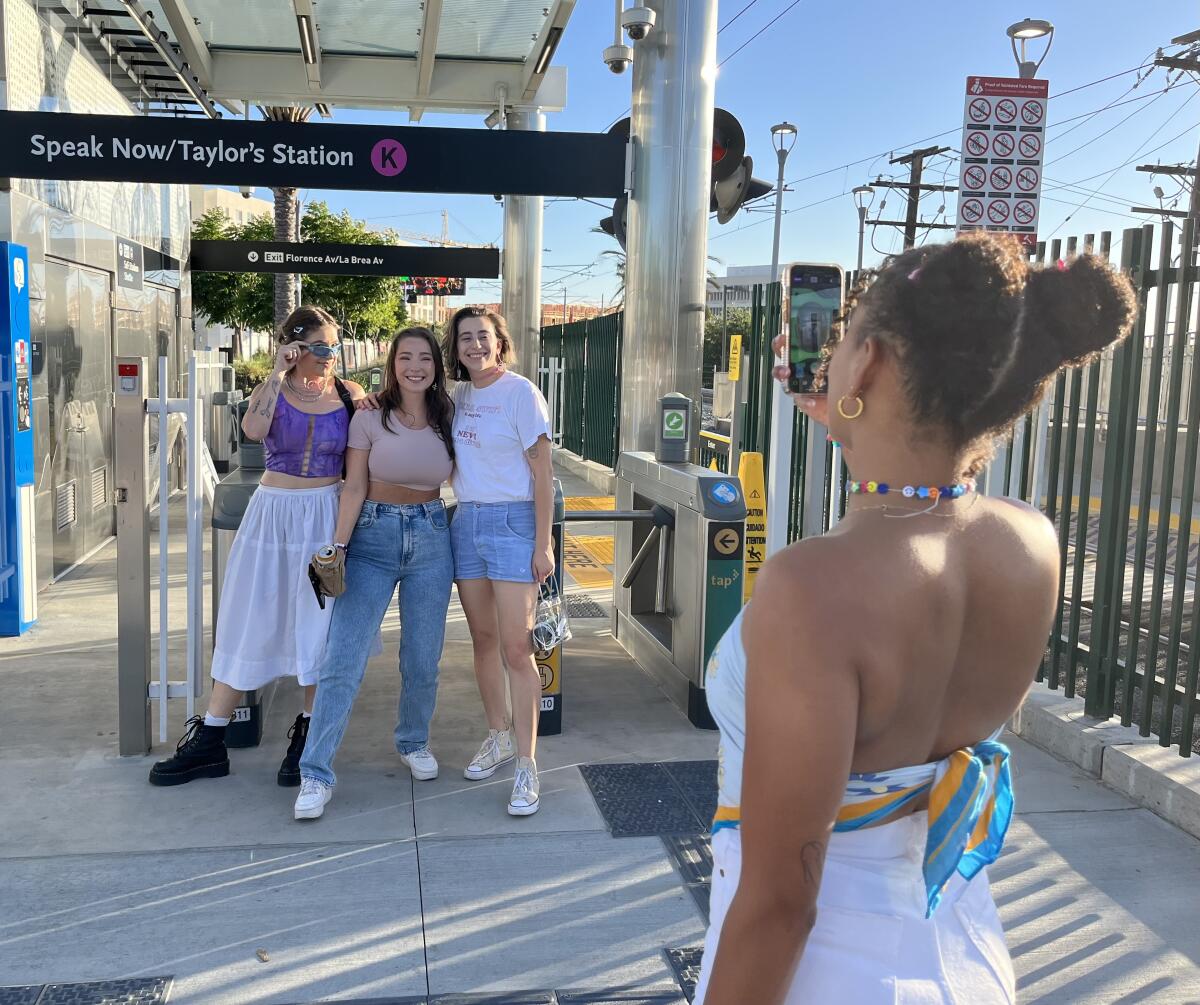
Conspiracy theories aside, the friends told me their transit experience has made them think about using the service more in the future.
“We were just saying we want to take it to the beach,” Vladimirova said. “It’s always really tough to find parking over there.”
We got off the rail line at Florence Avenue near La Brea Avenue and boarded an awaiting orange Metro bus to SoFi. It was as relaxed as the trains had been on my journey so far — there were only 12 other people aboard.
Once our bus pulled away from the K Line station, we hit epic traffic, crawling along La Brea in a mix of motoring SoFi sojourners and drivers making their evening commutes.
“Key segments” of the bus routes from both the K Line to the north of SoFi and the C Line to the south were supposed to have “transit priority,” Stephen Tu, Metro’s senior director of service development, told me last week ahead of the concert series.
But as we sat in gridlock for about 30 minutes to travel less than two miles, it was clear that priority didn’t happen. Eventually, the bus pulled into a dedicated parking lot and the Swifties made their way to the stadium gates, joining tens of thousands more fans adorned in sparkly dresses, cowboy hats, boots, wristfuls of friendship bracelets — plus the occasional boyfriend in a Karma shirt.
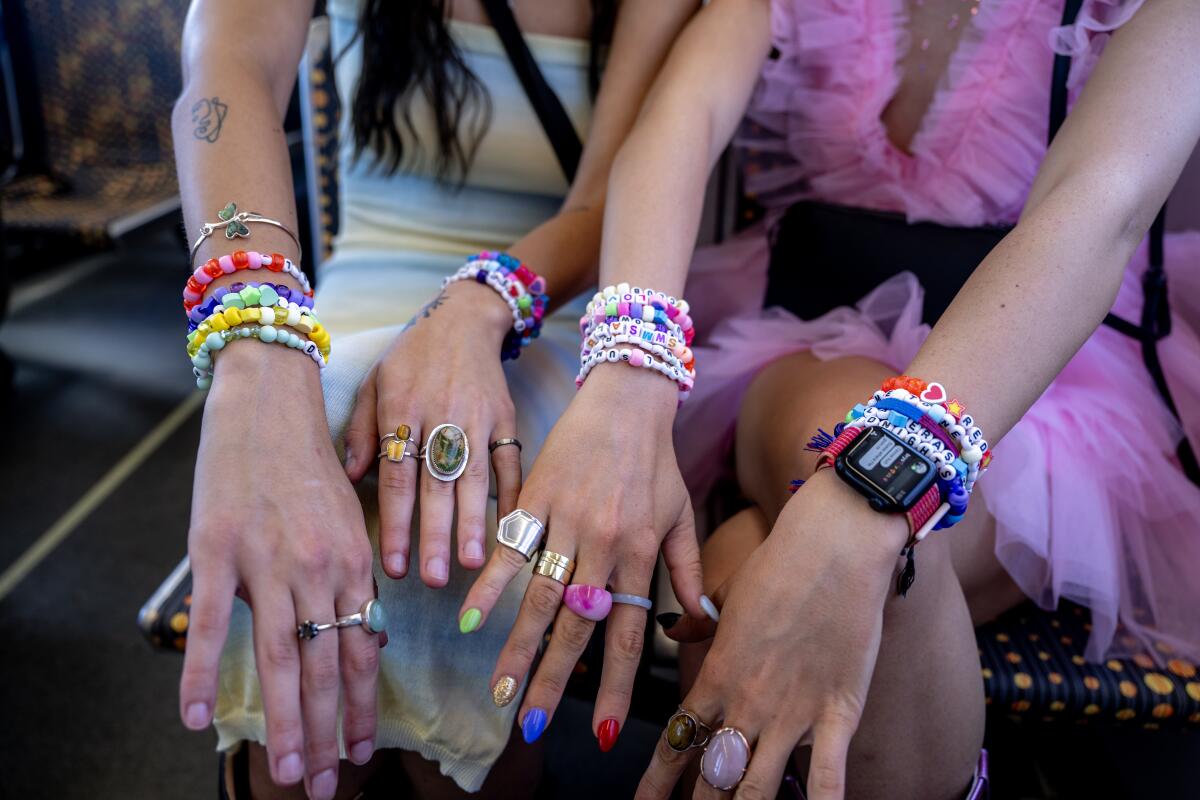
Bus operator Larry Barber, who’s been driving for Metro for seven years, said that shuttling for big events like this is generally easier and that drivers like to refer to them as “kickbacks.” But Barber also noted that drivers were expecting dedicated bus lanes for part of the route.
The city of Inglewood was supposed to manage the restriction of car traffic along Arbor Vitae Street, Metro spokesperson Tracy Smith later explained. But, she said: “People were ignoring the posted signs and the city didn’t staff to turn other vehicle traffic away.”
“We are continuing to work with the city to get transit priority where possible,” she said.
Leaving SoFi
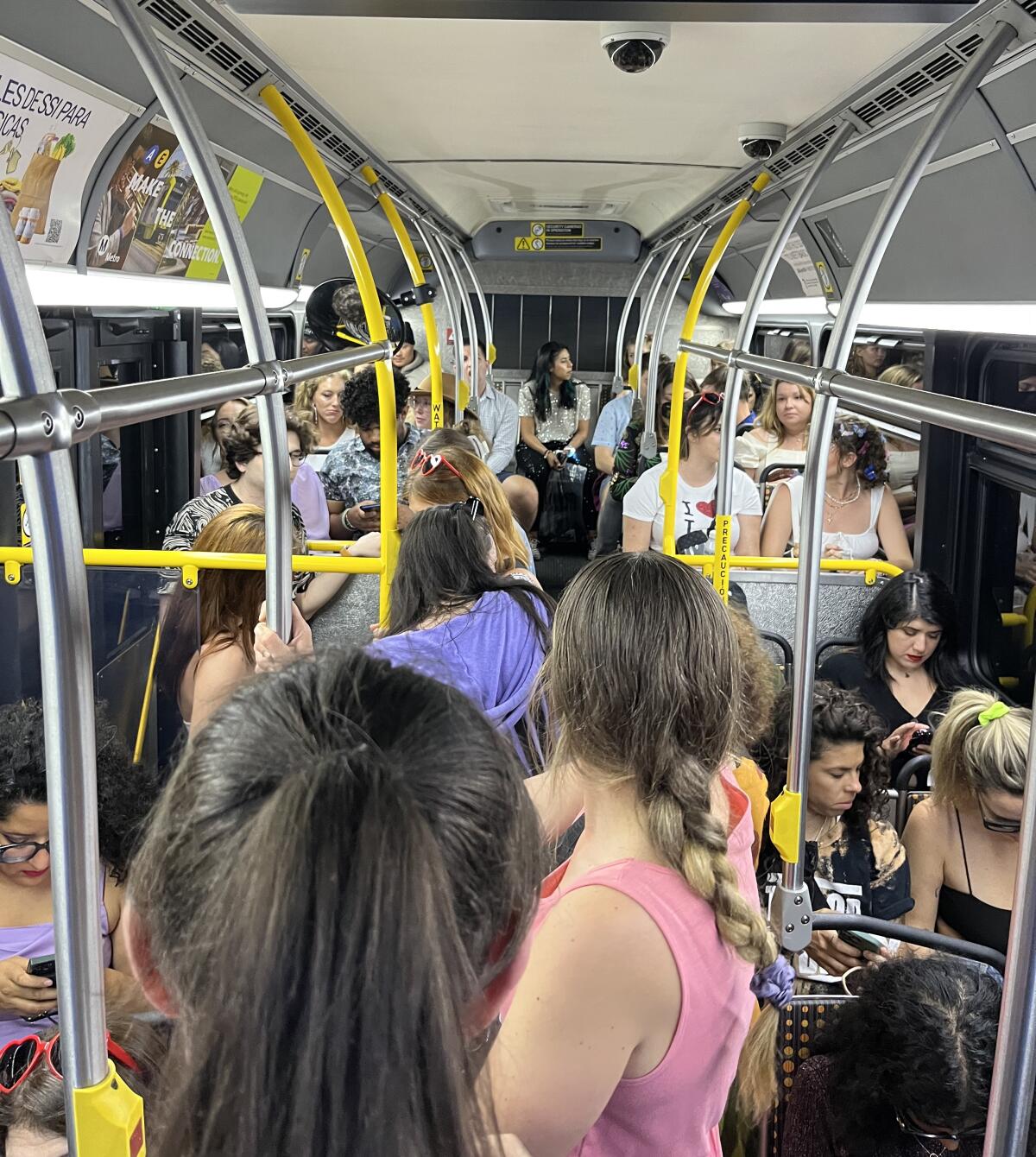
Swift’s opening show ended around midnight. Some Swifties tapped out before the performer had wrapped up, no doubt hoping to beat the absolute nightmare of congestion that’s inevitable when roughly 70,000 people all try to leave the same place at the same time.
I had waited outside the stadium and watched as a trickle of fans became crowds. Workers in reflective vests guided Swifties in their post-show bliss, asking them which line they were trying to reach — “C Line or K Line?” — and pointed them to rows of buses.
Buses began to fill up in minutes and headed out, once again crawling along in car traffic. I caught one of the first ones back to the K Line, squeezing in and grabbing a seat next to Danielle Alexander and Lauren Schwartz. Their post-show analysis: “Amazing.” They were particularly impressed with how Swift performed for more than three hours without any real breaks.
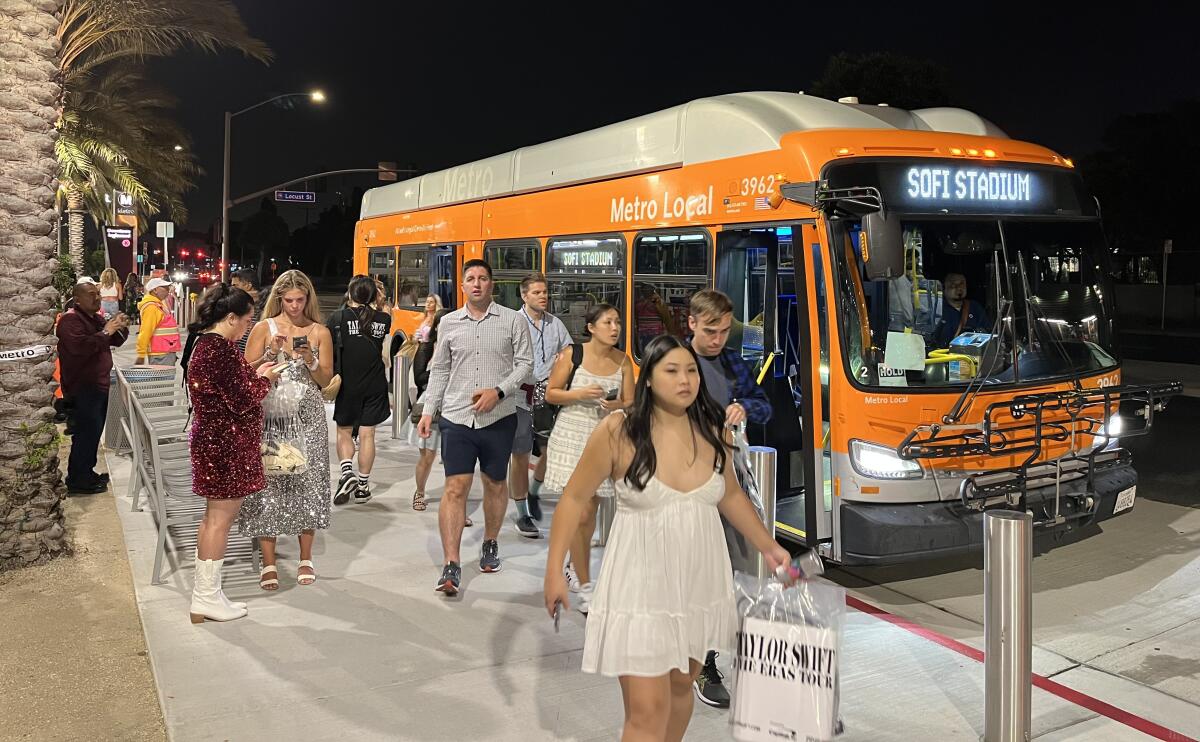
Fellow Swifties Donavan Weldon and Heather Biesemeier were also struck by Swift’s epic performance time.
“The stamina that woman has is out of control,” Weldon said.
The friends’ decision to take Metro was a simple calculation, Biesemeier explained: “Because we live in L.A., so we knew that was going to be insane leaving.” That knowledge comes with some experience, as she’d previously been stranded at SoFi waiting for an Uber.
“I saw the sign that said, ‘Swifties, do this,’” said Weldon, who rides Metro every day. “So we did it.”
Kelly Foster, went to the show with her daughter, Ada, and Kenia Lawler, the family’s former au pair flew in from Boston to join them. The trio headed back to Santa Monica, where they parked their car near an E Line station after driving from Pacific Palisades.
“By the time we get home, I think it’ll probably be the same amount of time as if we had parked,” Foster said. “And it’s nice to not have to be driving.”
Also an incentive: paying about $5 each for parking and train fare versus somewhere in the range of $50 to $100 or more to park at or near SoFi.
As I got closer to home, hopping from the K Line to the E Line to the A Line, the Swifties thinned out. By the time I hit my last stop, the train was mostly empty, save for a couple tired fans sporting their friendship bracelets.
Total time from Inglewood back to my front door: two hours, give or take a few minutes. I was curious how that compared with driving, so I asked my Swiftie sister-in-law, who drove to and from Saturday’s show. She said it took her an hour and half to get roughly eight miles to her home. When you consider my trip was roughly triple that distance, I’d say two hours is pretty good.
How’d ridership fare on opening night?
The Swifties I spoke to all seemed to enjoy taking transit for its ability to save them money and time — and avoid the stress of traffic to and from the stadium. But those fans represented a small fraction of the night’s concertgoers.
Metro officials estimated 4,630 Swifties rode the C and K lines and connecting shuttle buses to SoFi.
That’s about 6% of SoFi’s stated capacity of 70,000 people (but the actual concert attendance could be higher due to the configuration of special events). Far from the record-breaking transit figures boasted about elsewhere.
Granted, the first show was on a Thursday. It wouldn’t be a stretch to wonder if a larger share took transit to the shows on Friday and Saturday, when more people are off work. I asked Metro for ridership figures, but they weren’t available before filing this newsletter.
Still, it’s very on brand for Greater Los Angeles that the vast majority of concertgoers would opt for car travel over the regional network of trains and buses. There’s a complex mix of reasons, but one key factor? Proximity.
Unlike many major entertainment venues in major U.S. cities, there is no direct rail connection to SoFi Stadium. The closest stations for the C and K lines are each a couple of miles from the venue, requiring buses to ferry fans for the last leg of their journey, where the perk of dedicated space ended ... swiftly (sorry).
Compare that with the Santa Clara Valley Transportation Authority, which has a rail station just a few minutes’ walking distance to the Levi’s Stadium entrance — closer than many parking spots in the adjacent lot. That agency reported an estimated 25,000 boardings for Swift’s July 28 show — or roughly a third of the venue’s advertised capacity.
With three shows left to go in Swift’s SoFi stint, it’s likely thousands more Swifities will be boarding local transit. But given the region’s missed opportunities in terms of strong transit connections and entrenched sprawl that centers car travel, Swift might not bring the transit boost here that she’s brought elsewhere.
But if you’re going to an Eras show this week and want to avoid soul-sucking traffic, check out The Times’ handy guide to getting there via transit.
And now, here’s what’s happening across California:
Note: Some of the sites we link to may limit the number of stories you can access without subscribing.
Support our journalism
HEALTH AND THE ENVIRONMENT
A mother bear and her three cubs have been nabbed by wildlife officials after a spate of home break-ins in the Lake Tahoe area. The infamous family is now being split up. The mom is being relocated to a wildlife sanctuary, while the officials hope to reform the cubs’ behavior and release them back into the wild. Los Angeles Times
Contra Costa County health officials have ordered a Bay Area spa closed as they investigate two deaths associated with Legionnaires’ disease. Officials say the deaths — plus a third infection in which the patient recovered — were reported shortly after each person visited the Richmond spa. Los Angeles Times
CALIFORNIA CULTURE
What’s more Californian than surfing? Surfing and dogs! Pacifica hosted this year’s World Dog Surfing Championships, where man’s best friends donned colorful life vests, goggles and more as they rode waves to glory. San Francisco Chronicle
Free online games
Get our free daily crossword puzzle, sudoku, word search and arcade games in our new game center at latimes.com/games.
L.A. STORIES
Every day on Skid Row, unique mobile teams equipped with oxygen patrol the streets, looking to step in to save people from potentially deadly overdoses. “The vital gas has been a game-changer for the teams as overdoses have surged,” my colleague Emily Alpert Reyes reported. Los Angeles Times
Two women were killed and three other people were injured after a power boat erupted in flames Saturday in Long Beach. All five victims were in their 60s and the three survivors were being treated for burns. The vessel was believed to be docked for fueling when the fire started, though the exact cause remains under investigation. Los Angeles Times
Several nights of SoFi Stadium packed full of Swifties could be a windfall for street vendors selling food, drinks and merch. Here’s how they’re hoping to capitalize on the epic foot traffic. De Los
AND FINALLY
Today’s California landmark is from Chris Long of Los Angeles: the Point Reyes lighthouse in Marin County.
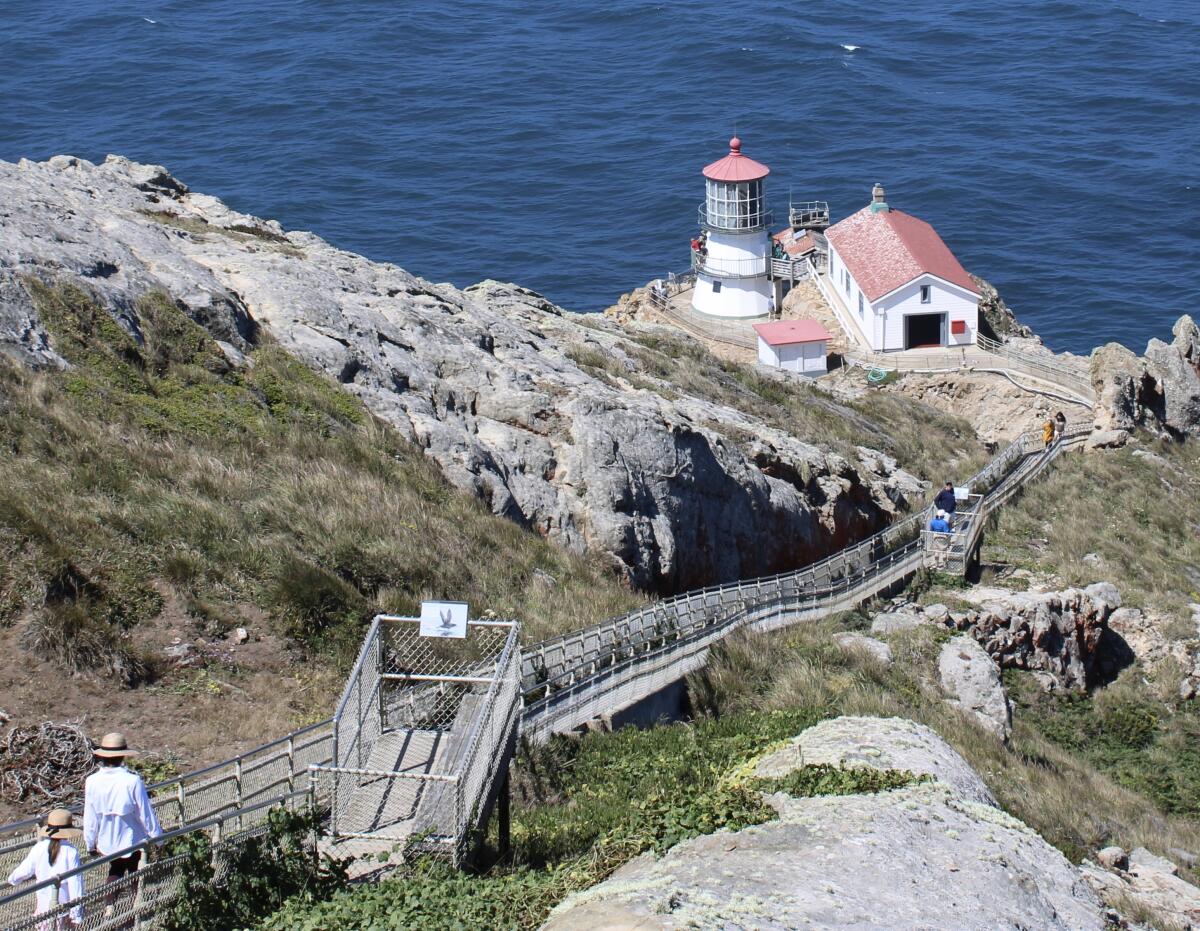
Chris writes:
The lighthouse was built in 1870 to help guide ships off the rugged and often foggy Marin County coast. Visitors must descend more than 300 steps to reach it.
What are California’s essential landmarks? Fill out this form to send us your photos of a special spot in California — natural or human-made. Tell us why it’s interesting and what makes it a symbol of life in the Golden State. Please be sure to include only photos taken directly by you. Your submission could be featured in a future edition of the newsletter.
Please let us know what we can do to make this newsletter more useful to you. Send comments to [email protected].
Sign up for Essential California
The most important California stories and recommendations in your inbox every morning.
You may occasionally receive promotional content from the Los Angeles Times.




